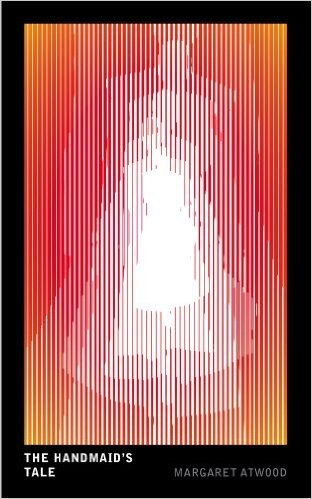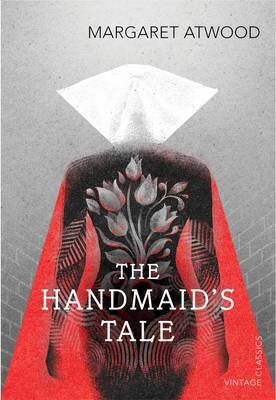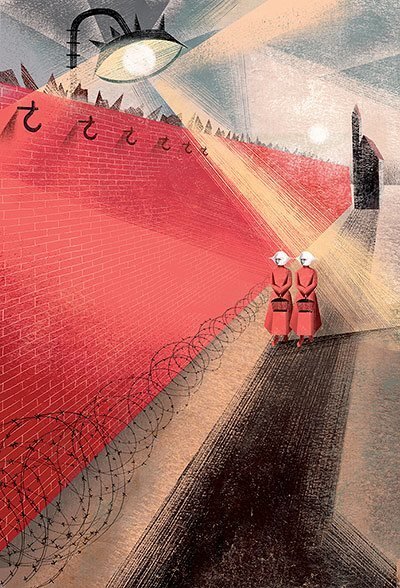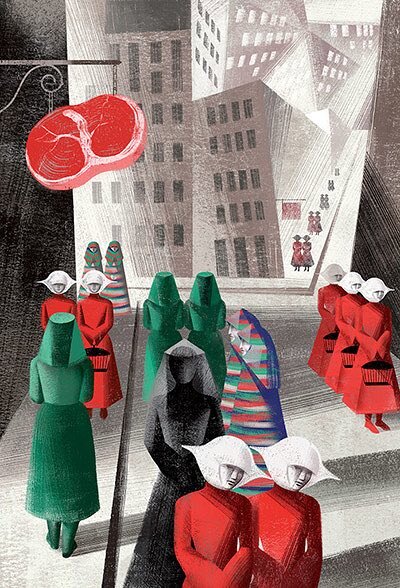The Handmaid’s Tale: 30 Years of Cover Designs
In the 30+ years since Margaret Atwood’s The Handmaid’s Tale was published, this dystopian classic has been through more cover re-designs than you might think. What comes to mind for most of us is the image of a woman in red, wearing that unsettlingly sharp white cap, dwarfed by an enormous wall.
The first American edition (1986)
As a rare book dealer who has handled first edition copies of this book, I can tell you that design comes not from the first edition (1985) – which was published in Canada with an appropriately creepy semi-cubist portrait of the handmaid and her Commander – but in the first American and first British editions that came out a year later.
The true first edition, 1985 (Canada).
The color red, both an evocative design choice and a key aspect of the narrative, has dominated most cover designs since. Whether the designer goes for something abstract and almost digital in appearance (as in the 2016 Vintage Classics edition) or strews the space with flowers (as in the 2009 Bloomsbury edition), the flash of red is eye catching and ominous. But the woman hidden behind a white veil in the McClelland and Stewart edition of 2006, however, demonstrates that red is not a requirement to hit the right tone.
Vintage Classics edition (“Vintage Futures”), 2016
Bloomsbury edition, 2009
McClelland & Stewart edition, 2006
The Handmaid’s Tale is a novel that begs for return, reassessment, play. Yes: play. The text is full of puns and black humor that are fertile (sorry) ground for a designer’s creativity. In this parade of cover designs, Vintage Classics most consistently turns out striking designs, such as the red-veiled woman whose face is blurred as if by Impressionist paint strokes (2005), or the line of red-stamped women who look not unlike Doctor Who’s Cybermen (2010).
Vintage Classics, 1996
Vintage Classics, 2005
Vintage Classics, 2010
Vintage Classics, 2016
Seal Books, 1986
Heinemann, 1993
McClelland and Stewart, 1998
Emblem Books, 2011
Blackwell‘s sent me this proof cover of a variant jacket design for a Jonathan Cape edition in 1986 which was never used. Designed by Ian Hands:
Proof design, Jonathan Cape, 1986
Around the world, too, there are some great covers: four eerily angled matches, mostly burned through, for a cover published in Russia; a closeup of the face of an old-school Hollywood noir woman, for a cover published in France.
Japanese edition on Kindle, ca. 2001
Russian edition, Эксмо [Eksmo], 2006
German edition, Claassen, München, ca. 1985
German edition, Verlag Ullstein, 2006
Spanish edition, Ediciones B, 2008
Spanish edition, Bruguera, 2009
French edition, Editions 84, 1998
French edition, Robert Laffont, 2005
French edition, Robert Laffont, 2015
French edition, Editions 84, 2006
That disconcerting 2006 French edition is an obvious opportunity to talk about how these book covers can teach us something. There are clearly Muslim overtones in the clothing worn by the woman in that edition, which suggests a transfer of the themes of the work (religiously inflected tyranny, especially over women) onto Islam instead of the book’s own Christianity. Given that, in the book, an authoritarian regime takes over through the ruse of staging a terrorist attack, the cover design seems to suggest a xenophobic warning that misses a number of important points made by the author.
To end, I’ll leave you with some images taken from the 2012 Folio Society edition, illustrated by Anna and Elena Balbusso.
First published 13 March 2013.



























